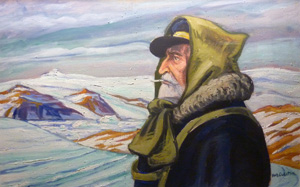
Jean-Baptiste Charcot - Pourquoi-Pas?
Second French Antarctic
Expedition 1908 - 1910
(Charcot's expeditions) "Occupy
a place in the front rank of the most important Antarctic expeditions.
No one has surpassed him and few have equalled him as a leader
and as a scientific observer"
- Edwin Swift
Balch.
"The gentleman of the Pole"
Robert Falcon Scott
The Crew Alphabetically
Aveline - Sailor
Besnard
- Assistant boatswain
Boland
- Sailor
Bongrain, H. -
sub-lieutenant, second officer
Charcot,
Jean-Baptiste - Commander of the Pourquoi-Pas?
and leader of the expedition.
Chollet,
E. - Skipper of the Pourquoi-Pas?
Denais
- Sailor
Dufreche - Sailor
Frachat - Motor engineer
Gain,
L. - Zoologist and botanist
Godfroy,
R. - sub-lieutenant, physical observations
Gourdon, Ernest - Geology and glaciology
Guegen, F. - Stoker
Guegen,
J. - Sailor
Herve - Sailor
Jabet, J. - Boatswain
Lerebourgh - Sailor
Lhostis
- Stoker
Libois - Stoker
and Carpenter
Liouville, J. M.D.
- Assistant doctor and zoologist
Modaine
- Cook
Monzimet - Stoker
Nozal - Sailor
Paumelle
- Mess steward
Poste, L.
- Second engineer
Rosselin - Chief
engineer
Rouch, Jules - sub-lieutenant,
physical observations
Senouque,
A. - Physicist
Thomas - Sailor
Van Acken - Second steward
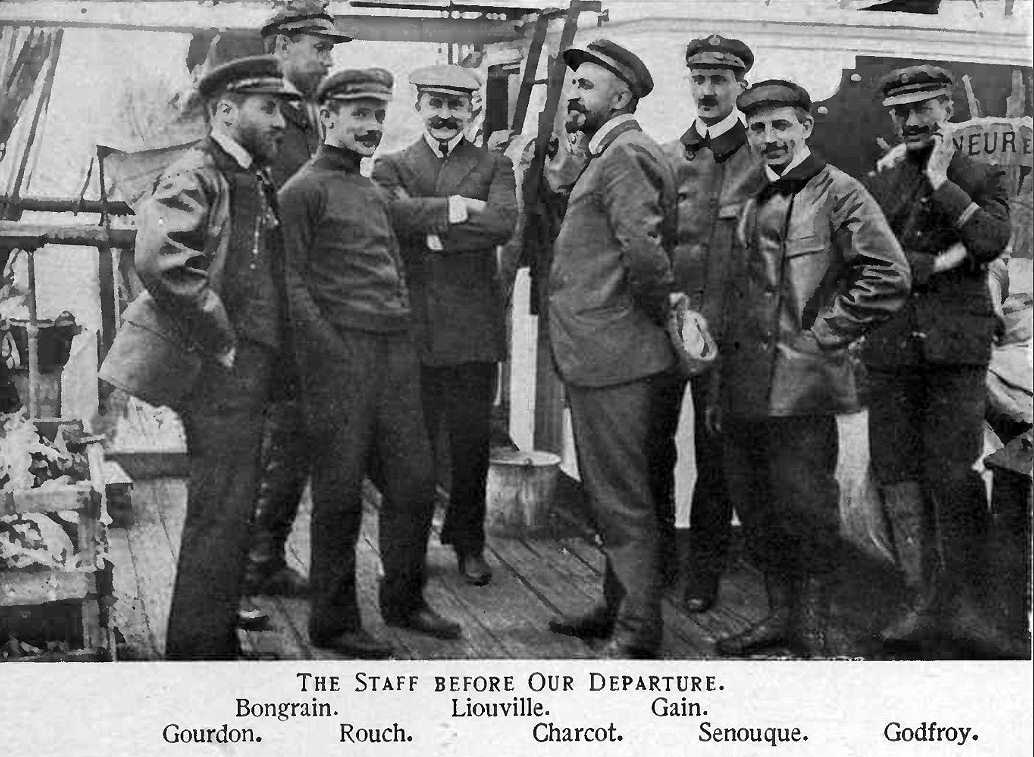
The Staff Before Our Departure
The enigmatically named Pourquoi Pas? (why not?) came from an event in Charcot's childhood when he was said to have written the words on the side of a soapbox and then launched himself in it onto a miniature pool at Neuilly-sur-Seine (France) where he was born and brought up. The box sank and he got wet, but it was the first of many voyages.
Charcot began preparing for his second Antarctic expedition almost as soon as he arrived back from his first on the Francais in 1905. It was far from clear whether or not the Antarctic Peninsula, a large portion the west coast of which had been surveyed by Charcot on his first voyage was indeed a part of the Antarctic Continent or simply a collection of islands.
The findings of his first voyage were well received by the scientific community and he submitted a prospectus for a further voyage to the French Academie de Sciences which was in turn well received. Charcot was riding on a wave of goodwill from the French Government and people, the overall budget was a fairly modest 800,000 francs (around £34,000) which was met largely (600,000 francs) from the governmental "Budget of the Ministry of Public Instruction". Other donations came from various sources, many of them public from Chambers of Commerce of several major French cities that no-doubt wished to be associated with France's latest hero at a time when international Polar heroics were a regular feature.
Further gifts of money, equipment and stores came from private manufacturers and foreign governments, such as those of Monaco (a complete oceanographic outfit), Brazil, Chile and Argentina. In particular the array of scientific instruments was the best ever carried by a polar expedition. Three naval officers were placed under Charcot's command by the Ministry of Marine and coal, instruments, maps and other materials were also donated.
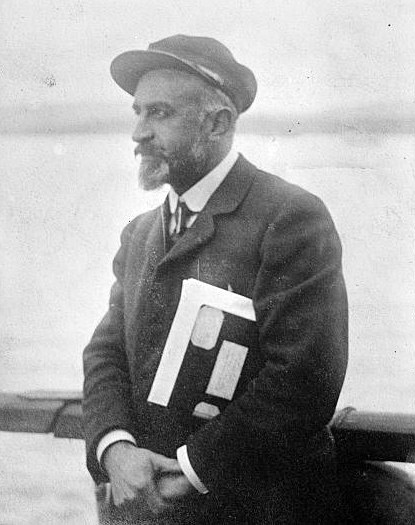
Initially Charcot tried to re-purchase the Francais sold to the Argentinean government at the end of his first voyage, but it was being prepared for use by Argentina's own Antarctic programme. The next thought was to purchase and convert a whaler or sealer from the Arctic fleet, but there was no suitable vessel. Eventually he turned once again to Pere Gautier of St.Malo who had so successfully built the Francais.
Gautier presented an estimate for the construction of the Pourquoi Pas? which while modest for what it represented used up about half of Charcot's budget. Having learned from the first voyage, the Pourquoi Pas? was to be stronger and faster than the Francais. She was built with thicker ribs and more of them than normal ships of her size, the ribs were covered with a double layer of thick planking, interior planking made an interior hull that was itself watertight. The ship was made entirely of oak other than the bilge of Elm and she was given a quality engine of 450 horsepower. The interior was provided with electric lighting and an effective heating system for the living areas. The Pourquoi Pas? was a fine ship much admired by those who fully appreciated her.
The men also had the best of available cold-weather clothing and were equipped with yellow-tinted snow goggles (no-one developed snow-blindness unless during the earlier expedition). There were also three motor cars that Charcot had been persuaded to take, though they were never used as ice surfaces were unsuitable.
The second French Antarctic Expedition aboard the Pourquoi Pas? sailed from Le Havre on the 15th of August 1908. She had twenty-two crew, of whom eight had been aboard the Francais, such was the loyalty that Charcot engendered, and including Charcot's recent wife Meg. On his return from the Francais expedition, his first wife had divorced him citing desertion. Charcot then lived with his also recently divorced sister for a while vowing never to marry again - but he was fortunate to meet a woman who realised that adventure was an integral part of the man. Meg (Marguerite) remained with the ship as far as Punta Arenas at the southernmost tip of Patagonia, before returning to France.
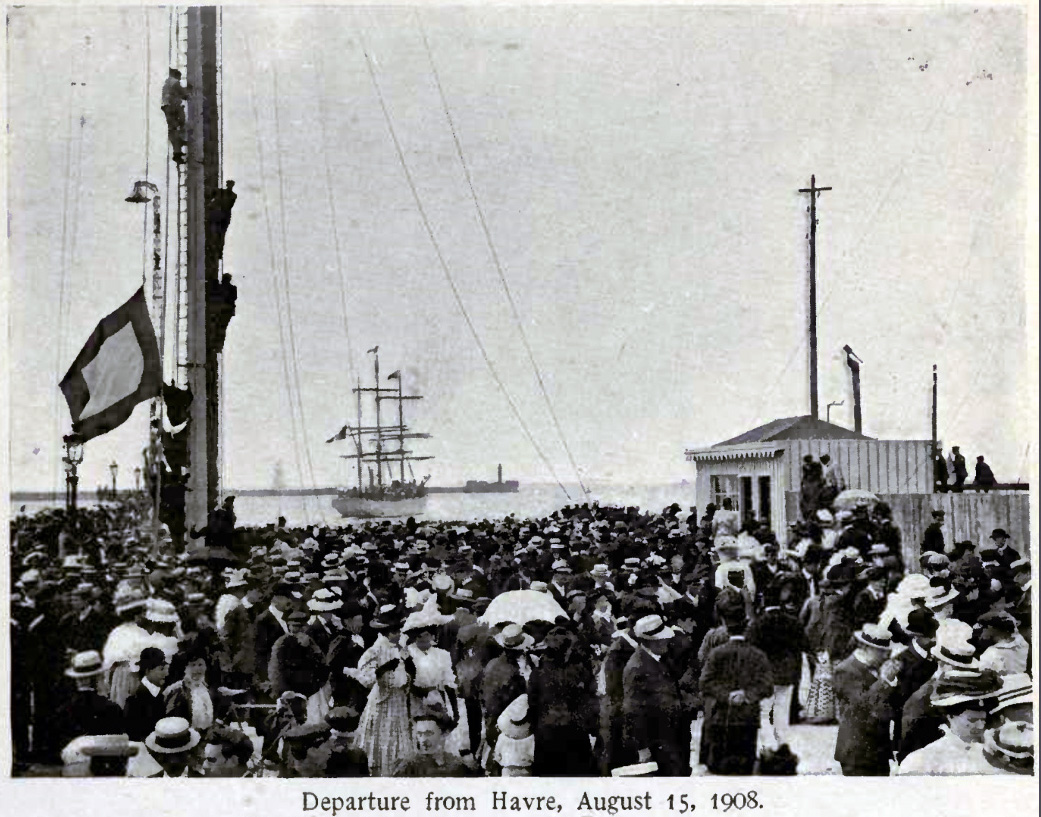
Departure from Havre, August 15, 1908.
The ship left Punta Arenas on December the 16th 1908 to the sounds of French and Chileans ashore shouting "Vive la France" . She headed first to the whaling station on Deception Island where Charcot was pleased to see the Norwegian and Chileans using the charts of the Northern Graham land Peninsula that he had made on his first voyage.
On the 29th of December, the Pourquoi Pas? reached the bay where the Francais had wintered in 1904, Charcot was surprised in going ashore to find that things were much as they had been left:
"I feel as though I've never been away".
On January the 1st a sheltered harbour was found at Peterson Island that was named Port Circumcision.
On January the 4th Charcot, Gourdon and Lieutenant Godfrey set out to reconnoitre Cape Tuxen and the nearby islands in a small motorboat in good weather but without any extra provisions or clothing. They thought they would be back aboard their ship within three hours, five hours later, they had eaten most of the food they had with them. Sea-ice drifted in between them and the ship and the weather turned to snow and sleet driven by a biting wind. The motor became clogged with ice formed by falling temperatures, Godfroy started to hack away at it with a spade, but to his horror dropped the spade through his cold-clumsy fingers. Resignedly, they went ashore where they waited for three days until conditions were good enough for the ship to be able to approach and effect a rescue.
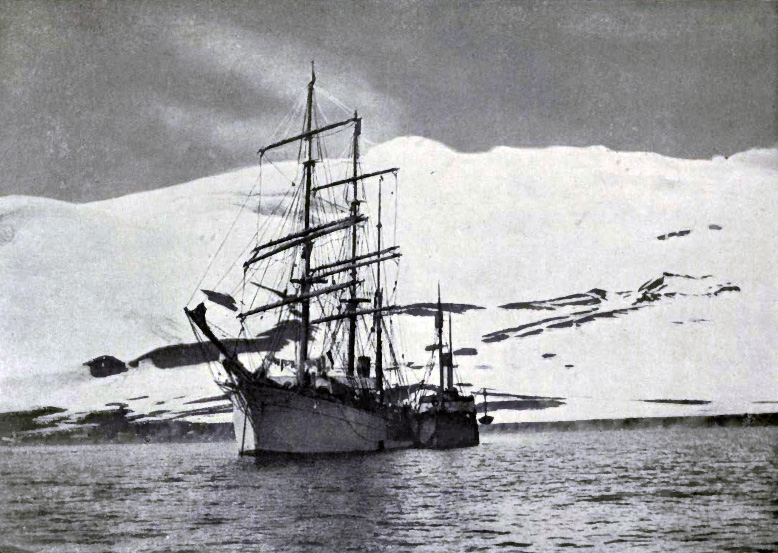 In
Antarctica
In
Antarctica
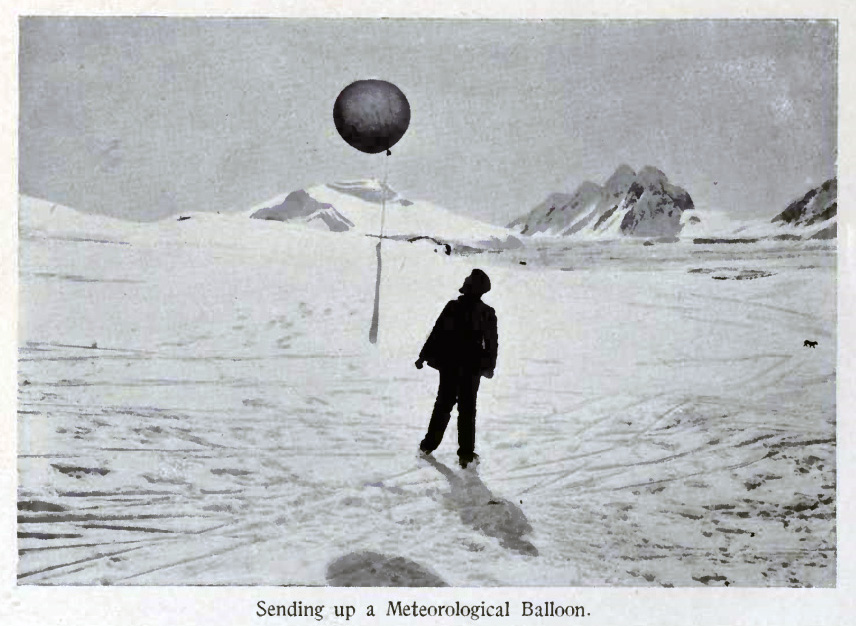 Sending
up a Meteorological Balloon
Sending
up a Meteorological Balloon
Within 24 hours in the middle of a meal while recounting the tale of their isolation and rescue, history repeated itself and the Pourquoi Pas? hit a submerged rock in a similar way to the Francais in a place not too far from where the Francais had been. The stern deck was flooded underwater and pieces of the false keel had been ripped off and floated to the surface. The bow was pinned down from the weight of anchors and chains.
The bow was emptied as best as could be managed to other parts of the ship or into boats and the plan was to float the ship off the rocks when the tide came in. Surely enough and with much grinding and noise, the ship floated off the rocks and made to a sheltered harbour where repairs were made, though there was a small leak, the pumps coped with it easily. Charcot decided to continue as before unaware how badly damaged the ship was.
The Pourquoi Pas? continued to sail south, crossing the Antarctic Circle at the end of January. Much work was done in charting coast and islands, features were identified and named. In particular Adelaide Island previously said to be 8 miles long was shown to actually be 70 miles long - testament to the difficulties in gauging visual perception in polar regions where clarity of the air can mean that mountains tens or a hundred miles distant can be seen easily. Progress was at once hampered by a proliferation of huge icebergs, but aided by many days of fine calm weather. Charcot discovered and named Marguerite Bay south of Adelaide Island after his wife and Jenny Island after Bongrain's wife, landings were made and a small party climbed to 1,500 feet where the coast could be seen extending into the distance, this was named Fallieres Land (now the Fallieres coast) after the French President at the time.
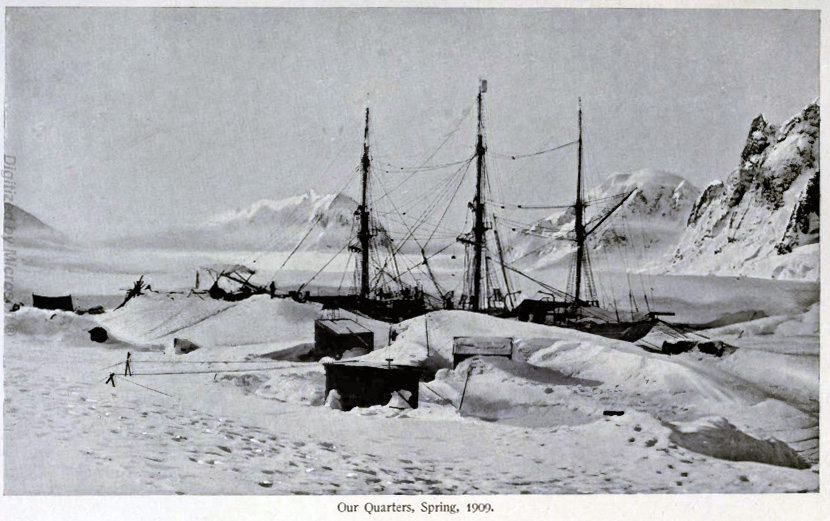 Spring
Quarters 1909
Spring
Quarters 1909
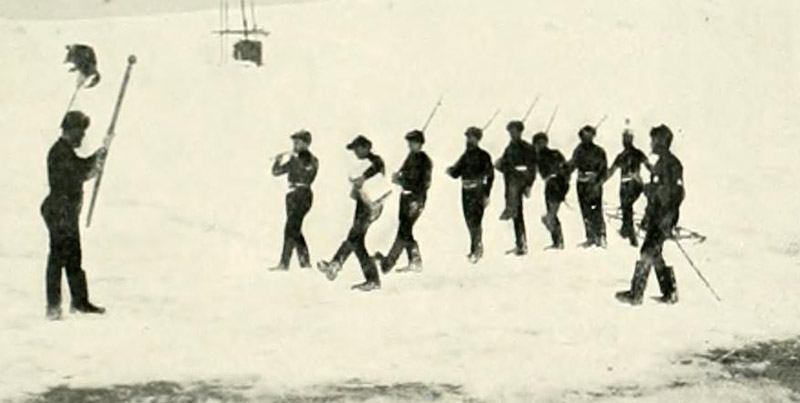 Shrove
Tuesday Parade 1909
Shrove
Tuesday Parade 1909
By the end of January, the ship had made it back to the harbour at Port Circumcision, Petermann Island, this was to be where the winter camp was to be made. Charcot had hoped to winter in Matha Strait to the south of Adelaide Island, but ice conditions necessitated a retreat to a known secure position. Unloading the instruments alone took the best part of a month. Four huts were erected and lit by electricity generated on the ship, the wires were carried aloft on bamboo poles from ship to huts. Heavy steel-wire hawsers were strung across the 275 ft entrance to the bay to stop icebergs from entering. The ship was secured in place and the decks tented over with canvas.
The late summer season weather was unseasonably warm with melt streams in February and rain in late March. Early April brought lower temperatures, but the living areas of the ship were unheated until mid April to try and conserve coal causing chilblains in many of the men, these disappeared when these areas began to be heated. Hyacinths, onions and watercress were grown under the wardroom skylight as late as April while there was still enough light to do so.
To pass the time as autumn gave way to winter after dinner classes were held in mathematics, grammar, English, first aid and almost any other subject that there was sufficient expertise amongst the crew for someone to share their knowledge the "Antarctic Sporting Club" was founded for ski and sledge races could be held, medals were cut from food boxes and cans and given to the victors. A particularly popular diversion were readings from Rouche of his novel as it was written "The Typists Lover".
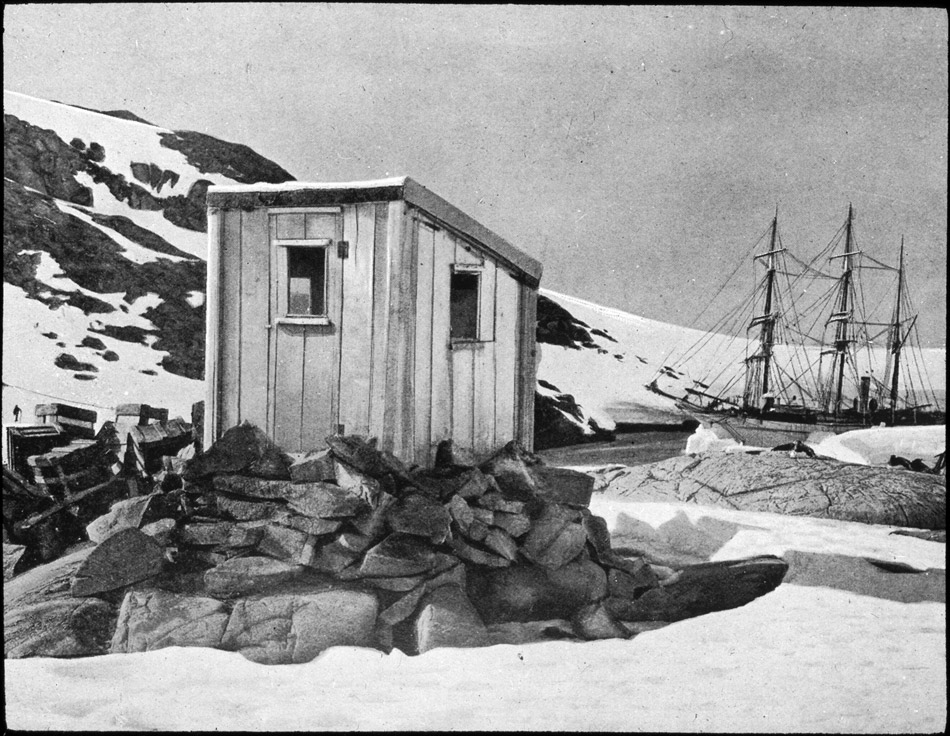
Porquoi Pas? and a small hut, one of four
In mid June a ferocious storm broke, the ship strained against its moorings and jammed against a rock. Ice blocks swept into the harbour and one broke away 2/3rds of the rudder which was unshipped and repaired only with great difficulty. Midwinter brought general malaise and depression, similar afflictions that had affected the crew of the Belgica during the winter. Charcot in particular became ill and he diagnosed himself with a serious heart condition, his legs became badly swollen and he struggled to breathe without pain. A regime of fresh meat, exercise and antiscorbutics (foods with vitamin C taken against scurvy) was undertaken which had a positive effect.
The major expedition of the spring was to have included Charcot, but he was still too ill and so on September the 18th a party of six was sent to survey Graham Land without him. They reached 16 miles from the ship, finally accepting they could go no further in a spectacular place they named the "Amphitheatre of the Avalanches".
More local trips continued to be made and there was plenty to occupy the scientists in the immediate vicinity, though several men still fell ill and needed to be put onto the antiscorbutic regimen. Charcot still was too unwell to go very far from the ship. They left their winter quarters on the 25th of November sailing for Deception Island to resupply their coal reserves as they had insufficient for a second winter. Amongst news they received was that Ernest Shackleton, earlier the same year - 1909, had reached 97 miles of the South Pole, the North Pole had been reached by the American Robert E. Peary in April 1909 and a Frenchman, Louis Bleriot, had made the first powered flight across the English Channel.
The Pourquoi Pas? was now leaking more and more and the Norwegians offered the services of a diver who inspected the damaged hull. A large section of the keel had been torn away along with other damage, Charcot was advised to sail for home straight away as even ice-free navigation had its risks and even a modest encounter with ice might sink the ship. In a move of uncharacteristic recklessness, he chose to sail south once again to uphold his nation's honour and personal reputation, he did not share the information about the ship fully with his officers and crew. On the 23rd of December 1909 he sailed south once again.
By the 11th of January 1910 they were sailing towards the south of Alexander Island at about 70°S, 77'W when Charcot made his most important land discovery that he named Charcot Land after his father. They tried to approach closer, but the ice precluded it and further damage to the ship could not be risked. On the 22nd of January, the ship turned north and headed for South America arriving in Punta Arenas to congratulatory telegrams from all over the world on the 11th of February. She underwent extensive repairs in Montevideo (Uruguay), was scrubbed and painted in the Azores and was back in France on the 4th of June, reaching Rouen on the 5th.
The results of the second French Antarctic Expedition had been impressive, 1,250 miles of coastline and newly discovered territory had been surveyed. The maps made from the expedition were still in use twenty-five years later. The scientific data filled 28 volumes, including some of the 3,000 photographs taken during the expedition.
I was a FID for two winters (1962-64) at
Base F. Charcot based his exploration (in the winter
of 1909) on Peterman Island and a metal plaque on a cairn
there records the members of his team. With two colleagues,
I was (as far as I know) the first since then who tried
to follow in the footsteps of Charcot. We were attempting
to find a route onto the Graham Land Plateau for dog teams.
We failed but did the first ascent of the nearby Mount Shackleton.
Robert (Bob) Lewis - by email
Landmarks named after the Pourquoi Pas?
Feature Name:
Pourquoi Pas? Glacier
Feature Type: glacier
Latitude:
66°15'S
Longitude: 135°55'E
Description: Glacier 4 mi wide and 15 mi
long, flowing NNW from the continental ice and terminating in
a prominent tongue 9 mi WNW of Pourquoi Pas Point. Delineated
by French cartographers from air photos taken by USN OpHjp,
1946-47. Named in 1952 by the French Antarctic Sub-committee
after the Pourquoi-Pas?
Feature Name:
Pourquoi Pas? Glacier Tongue
Feature Type: glacier
Latitude: 66°10'S
Longitude:
136°00'E
Description:
Prominent glacier tongue 4 mi wide and 6 mi long, extending
seaward from Pourquoi Pas Glacier. Delineated from air photos
taken by USN OpHjp, 1946-47, and named for the French polar
ship Pourquoi-Pas?.
Feature Name:
Pourquoi Pas? Island
Feature Type: island
Latitude:
67°41'S
Longitude: 067°28'W
Description: Mountainous island, 17 mi
long and from 5 to 11 mi wide, lying between Bigourdan and Bourgeois
Fjords off the W coast of Graham Land. Discovered by the FrAE
under Charcot, 1908-10. The island was charted more accurately
by the BGLE under Rymill, 1934-37, who named it for Charcot's
expedition ship, the Pourquoi-Pas?
Feature Name:
Pourquoi Pas Point
Feature Type: summit
Latitude:
66°12'S
Longitude: 136°11'E
Description: Ice-covered point which forms
the W side of the entrance to Victor Bay. Charted by the FrAE,
1950-52, and named in 1954 for the French polar ship Pourquoi-Pas?
 Let
Heroes Speak: Antarctic Explorers, 1772-1922
Let
Heroes Speak: Antarctic Explorers, 1772-1922 A brief synopsis of all major expeditions to Antarctica from Captain Cook to Shackleton.
 The
Voyage of the "Pourquoi-pas?"
The
Voyage of the "Pourquoi-pas?"Jean Charcot (Author), Philip Walsh (Author), P. Walsh (Translator)

 Charcot
of the Antarctic
Charcot
of the Antarctic